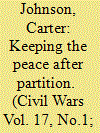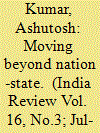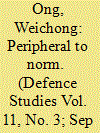| Srl | Item |
| 1 |
ID:
144444


|
|
|
|
|
| Summary/Abstract |
This paper examines partition as a solution to ethnic civil wars and modifies the ethnic security dilemma, suggesting that strong state institutions are more important than demographically separating ethnic groups to achieve an enduring peace. The paper starts with a puzzle: if ethnic separation is required for peace, how do some partitions that leave minorities behind maintain peace? The paper compares post-partition Georgia–Abkhazia, which experienced violence renewal within five years of the partition, with post-partition Moldova–Transnistria, which maintained peace. Both countries had ‘stay-behind’ ethnic minorities. The paper also disaggregates and compares the territories within post-partition Abkhazia, which contain ethnic Georgians: Lower Gali experienced violence while neighboring Upper Gali did not. The paper argues that state institutions create an incentive for ethnic minorities to collaborate with the state, regardless of minority preferences, and this helps maintain peace. However, preferences become important where institutions are weak and members of the ethnic minority have the opportunity to defect; this increases the likelihood of violence. The results build on the ethnic security dilemma by specifying micro-mechanisms and challenging the theory's reliance on intransigent ethnic identities in explaining the causes of post-partition violence.
|
|
|
|
|
|
|
|
|
|
|
|
|
|
|
|
| 2 |
ID:
155043


|
|
|
|
|
| Summary/Abstract |
The article refers to the processes that have been critical to the emergence of states as significant categories for the analysis of politics in India after a considerable period of academic neglect. It is in this context that the article considers the following research questions for discussion while referring to the state politics literature: what has been the contribution of the “first generation” of state-specific studies and to what extent has the “second generation” of inter-state comparative studies been able to take this forward? What could be the specific advantages of inter-state studies over single case studies? Finally, the article argues in favour of a need to develop further what may be considered the “third generation” of studies in the discipline, that remain comparative in nature but are in search of a much-nuanced grounded analysis; this would move beyond state-specific or inter-state studies and start taking up intra-state comparative studies, focusing on historical-cultural substate regions that have emerged as political (and economic) units within and across the constituent states of the Indian Union.
|
|
|
|
|
|
|
|
|
|
|
|
|
|
|
|
| 3 |
ID:
108613


|
|
|
| 4 |
ID:
149606


|
|
|
|
|
| Summary/Abstract |
Long-standing efforts to develop a commercially viable laser-based process for uranium enrichment, initially with atomic and later molecular isotope separation, have had limited success. This article discusses a model for a third generation of laser enrichment technology where CO2 laser light is Raman scattered to generate 16 μm photons that excite a vibrational mode in uranium-235 hexafluoride molecules within an adiabatically expanding free carrier gas jet, allowing for the partial separation of uranium isotopes by condensation repression. The SILEX (Separation of Isotopes by Laser Excitation) process being developed as part of the Global Laser Enrichment project may be one example of this separation technique. An ideal, asymmetric cascade for enriching uranium to weapon-grade levels is presented, and an analysis of the minimum laser performance requirements is included. Optimal running parameters, physical space constraints, and energy efficiency estimates are discussed. An assessment of the technical skills required is also provided. Finally, material available in an online supplement discusses possible lasers that may be utilized in such a process, and offers an introduction to dimer formation, a laser-based enrichment cascade, and a model for estimating the enrichment factor.
|
|
|
|
|
|
|
|
|
|
|
|
|
|
|
|